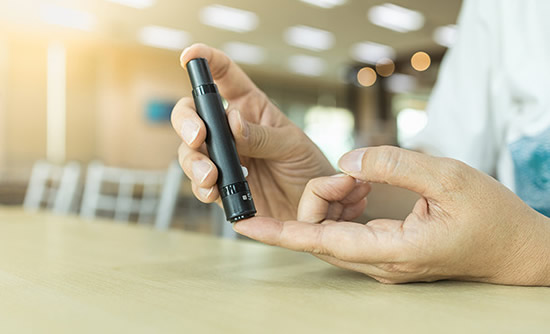Researchers explore at-home testing method of viral loads for HIV patients
by Sarah Small
 Penn State researchers are developing a new method to monitor the effectiveness of HIV treatment that uses a finger prick test, which patients will be able perform at home. IMAGE: ISTOCK/@MTHIPSORN
Penn State researchers are developing a new method to monitor the effectiveness of HIV treatment that uses a finger prick test, which patients will be able perform at home. IMAGE: ISTOCK/@MTHIPSORN
UNIVERSITY PARK, Pa., October 15, 2020 - Development of a new method to monitor the effectiveness of human immunodeficiency virus (HIV) treatment at home instead of in hospitals is underway by Penn State researchers. The research is supported by a three-year, $1,012,996 grant from the National Institutes of Health (NIH).
When people undergo antiretroviral treatment for HIV, mortality and morbidity rates are reduced significantly by reducing the viral load, or the amount of virus in a person’s blood, to undetectable levels. In order to ensure the success of the treatment, patients need to be tested routinely to check their viral loads.
“The current monitoring of viral loads requires a hospital visit,” said Weihua Guan, principal investigator (PI) and assistant professor of electrical engineering in Penn State’s School of Electrical Engineering and Computer Science. “Therefore, the frequency of monitoring is limited.”
Currently, testing of viral loads relies on nucleic acid testing (NAT), which cannot be conducted outside of hospitals and laboratories because of the testing complexity. Guan and co-investigators Dr. Cynthia Whitener, professor of medicine at Penn State College of Medicine and chief of the Division of Infectious Diseases at Penn State Health Milton S. Hershey Medical Center; Dr. Wallace Greene, associate professor of pathology and medical director of the Clinical Pathology Diagnostic Virology Laboratory; and Dr. Jonathan Nunez, assistant professor of medicine, are changing that.
“We are developing a quantitative nucleic acid test on an ultra-compact device to detect viral rebound that is simple enough for laypersons to test themselves,” Guan said.
The new method will enable patients to use a finger prick test at home, similar to the concept of insulin monitoring for people with diabetes.
In this initial phase of research, the researchers plan to design, manufacture and validate five prototypes. They estimate that the components for the at-home testing — a durable analyzer and a disposable microfluidic chip — will be $50 and $1.50, respectively. If these milestones are met, the project will transition to the next phase, granting the researchers an additional $1,317,127 in funding, distributed over two years, from NIH.
“I am very excited about the interdisciplinary collaboration and innovation,” Guan said. “If proof-of-concept of the device and its validation is successful, this project will significantly enhance the treatment outcomes for patients under therapy.”
###
MEDIA CONTACTS
Megan Lakatos
mkl5024@psu.edu
Work Phone: 814-865-5544
Source: https://news.psu.edu/story/635729/2020/10/15/research/researchers-explore-home-testing-method-viral-loads-hiv-patients
"Reproduced with permission - "The Pennsylvania State University"
The Pennsylvania State University
|